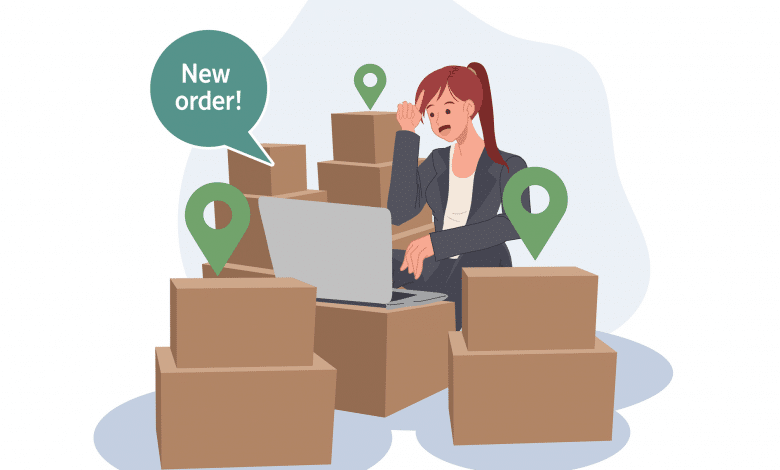How to Deal with eBay Returns as a Seller

Whether you’re selling on Amazon, eBay, or some other marketplace, dealing with customer returns is part and parcel of being an online seller—if you’re not careful, though, the costs of these returns can add up and eat into your bottom line.
In this article, we’ll answer some important questions about dealing with eBay returns and how you can maintain your reputation on the marketplace.
Also Read: Beginner’s Guide to Selling on eBay
Does eBay Require Sellers to Have a Return Policy?
Technically, no. eBay does not have a hard rule on sellers offering to accept returns to buyers. However, it does have its own guarantees in place to make sure buyers are protected when necessary. So it’s entirely possible not to have a returns policy in place as a third-party eBay seller, but you will still be subject to things like eBay’s Money Back Guarantee.
If you want to succeed on the eBay marketplace, though, a returns policy is essential. Make sure to communicate your policy and specific instructions to customers to minimize your exposure to returns scams. Here are some things (which still need to be in line with eBay’s policies) you need to determine for a solid returns policy:
- Within what period can buyers return your items?
- Will you be offering item exchanges or a money back guarantee?
- When is the buyer entitled to full or partial refunds?
- Will you charge a restocking fee?
Who Pays for Return Shipping Costs?
For returns covered by eBay’s Money Back Guarantee policy, that is, returns where the item didn't arrive, is faulty or damaged, or doesn't match the listing, the buyer is entitled to a full refund for the item, including the cost of the original shipping and return postage costs.
For any other reason, you may charge the return costs to the buyer as long as it was communicated clearly as part of your returns policy in your product listing.
Should I Always Issue a Refund on Customer Returns?
For returns covered by eBay’s Money Back Guarantee policy, particularly, if an item didn't arrive, is faulty or damaged, or doesn't match the listing, customers are entitled to a full refund including shipping costs and eBay will charge that to your account.
In other cases, you can extend a partial refund offer to the buyer and let them keep the item in order to avoid the lengthier process of taking the item back and relisting it for sale. For the most part, however, you’ll have to accept the return and issue the refund promptly. Keep in mind that Item Not as Described (INAD) requests tend to be the most costly and are the cases you really want to avoid, as eBay will also charge you for the cost of the original shipping as well as the return costs.
What Happens When a Buyer Requests a Return?
When a buyer requests a return, the return process within eBay is triggered and you will be notified via email that the buyer has initiated the request. eBay says the sellers have 3 days to respond to the request and another 3 days to issue the corresponding refund if applicable. Your options are thus:
- Accept the return and send the buyer a return shipping label they can stick onto the return shipment
- Let the buyer keep the item and issue a refund (in cases where the return shipping is more costly)
- Offer the buyer a partial refund and let them keep the item
- Offer other acceptable means to resolve the buyer’s issue
Once you accept the return request, the buyer will have 14 working days from the time of the request to process the return shipment. You will then have the opportunity to inspect the item when it gets taken back in to validate the buyer’s reason for returning the item. The ticket will then be closed and the applicable eBay final value fees will be reflected on your next seller invoice.
How does a customer ask eBay to step in on a product return?
From a buyer's standpoint, if you fail to facilitate the return and refund smoothly, eBay can step in if you haven't replied in three business days. All they need to do is head to their purchases tab > see request details > see return details (if the goal is to return an item) > Ask eBay to step in and help.
Once eBay steps in, it usually takes them one to two business days to respond. They will usually ask the customers to return the item and issue a refund to a buyer. But if you've continually been unresponsive, they can issue refunds even though the customer hasn't returned the item.
On the other hand, if you fail to come up with a resolution with your customer, you can ask eBay to step in and resolve the issue. All you have to do is go to Returns & Refunds of Seller Help > Take Action beside the item > Ask eBay to step in.
You also have the option to ask eBay's help from Seller Hub. To do this, go to Orders > Returns or Requests and disputes > See details > Report Problem.
How Do I Respond to a Return Request on eBay?
The very first step in dealing with customer returns is to assess the situation—that is, why the customer wants to return the product in the first place. These issues can range from easy fixes to more complex issues that you may need to resolve with the buyer.
To ensure you maintain your great reputation on the eBay marketplace, make sure to respond professionally to return requests within 3 business days. If you’re unresponsive after this period, the customer can ask eBay to step in and help, which may cause a whole plethora of other problems that could affect your business.
In cases where a return is valid, be sure to offer a satisfactory resolution. This can include an apology for the mishap if it was an honest mistake, providing a refund for the item, offering a replacement or exchange for a similar item if the buyer agrees, and in some cases facilitating a repair if possible.
How Do I Validate the Reason for Return?
When a customer initiates a return request, you’ll be given the opportunity to review the reason for returning the product and comparing it to your return policy. If the reason for the return is covered, you will have another opportunity to validate the reason for the return when you receive the item back and put it through inspection.
On the other hand, if the return is merely based on buyer’s remorse or false claims about the product. You may communicate your denial of the return request and provide evidence as necessary via eBay’s messaging platform.
Also Read: Selling on Amazon vs. eBay 2023
How Do I Handle INAD eBay Returns?
As an eBay seller, this is the last section you'd want to find answers to. INAD items are items that fail to meet the buyer's expectations due to inaccurate details on the listing or photos. When you encounter an INAD return, you're required to respond within three business days.
Failure to do so will result in eBay stepping in and if their investigation favors the buyer, it will affect your Sellers Performance Standards (SPS) and overall revenue since you're required to pay for the return shipping fee.
This situation can be frustrating for any eBay seller. The best way to handle this situation is to accept the faulty item and issue a refund to your customer. If you have a strong belief that you're being scammed by a customer, you can also escalate the problem to eBay.
To do this, first take a picture of the item. Upload it to eBay and leave a comment that the refund or return can't be handled since you're investigating a fraud. Next, create an online police report in the buyer's country then send it to eBay.
How Do I Do a Patrial Refund on eBay
Partial refunds are cases where you meet half way with a customer to resolve a return or refund request. The money you need to refund typically depends on the reason the customer wants to return an item in the first place. If the reason is due to minor scratches, you may only need to issue a quarter refund. If the product has serious damage but still functional, you may be required to refund half the price of what the customer paid for.
Before you do offer this as a solution to your customer, remember that this option isn't available every time. If the customer accepts your partial refund offer, you can choose to pay via PayPal or eBay managed payments.
To send a partial refund request to a customer, follow these five simple steps:
-
- Go to Returns dashboard
- See return details beside item under Actions
- Select offer partial refund
- Enter amount you want to refund
- Click on submit offer
How Do I Avoid Customer Returns on eBay?
Just like on Amazon, there is no surefire way of avoiding customer returns on eBay. However, there are a couple of effective ways to minimize your exposure to fraudulent returns.
One of the biggest reasons why customers return orders is that it’s not exactly what they expected to get when they viewed the product description and images. Always make sure to be as accurate as possible when describing your product and don’t show images that don’t accurately depict its features, or worse, are not your actual product at all. Be transparent about any flaws, measurements, or specific conditions of the item.
Another key thing you wanna do is evaluate your returns and learn from them. Knowing why buyers return some of your orders will go a long way in helping you address similar problems in the future and will even help you improve your products if you’re trying to build a sustainable business on the platform. This process can involve analyzing patterns or recurring issues about your product returns, doing a quality check based on the most common user comments, and optimizing your listings accordingly.
Conclusion
Dealing with customer returns as a seller on eBay can be frustrating and time-consuming, but understanding eBay's policies on returns and learning from your return patterns are essential to succeeding on the platform. Furthermore ensuring exceptional customer service during the entire process can help you protect your reputation on the marketplace and minimize your exposure to fraudulent returns.
How do you deal with customer returns on eBay? Let us know in the comments below.





